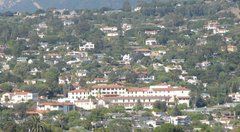
Starting around 1975 residents of Santa Barbara planned to contain and limit growth. A stable population of 85,000 was set as the goal and residential properties were then "down-zoned" decrease density.
In 1989 the city re-examined its planning goals. Commercial development, which had not been "down-zoned", had outstripped residential growth. Local defense industries and medical services were strong draws to Southern Californians. Thus the city was pulled into the development orbit of the Los Angeles area in spite of its resistance.
Real estate prices forced lower income and younger age groups out of the city while existing residents retired out of the workforce. Many current workers now live outside the city (in areas such as Santa Rosa and Ventura) and commute in. This causes periodic transportation problems and threatens future productivity and competitiveness of the city.
Today the city recognizes that its economic and cultural health rely on increased affordable housing. With the natural geographic limitations of the hills and the ocean this increase in housing will require an increase in housing density and new types of living arraignments.
Significant infill has already pushed multiple homes into existing single family lots surrounding downtown. The house my family lived in on West Islay Street was a duplex when we lived there in the 70's. Today three additional units have been built into a new building in what was once our backyard.
The redevelopment of St. Francis Medical Center into housing is an opportunity to showcase a possible model for future infill and redevelopment for the city. An environmentally and socially sustainable project could reset local attitudes towards the kind of increased density and mixed-use development that will be required to manage the growth that Santa Barbara now realizes is inevitable and even desirable for long term civic health.

No comments:
Post a Comment